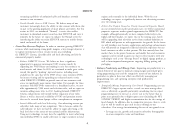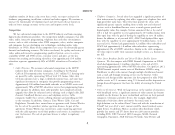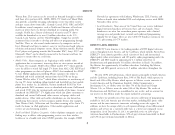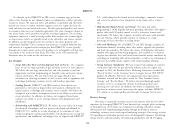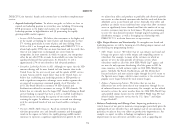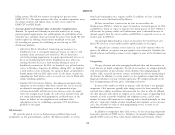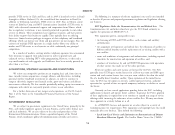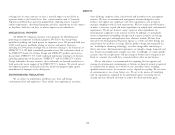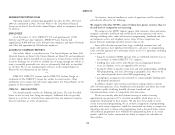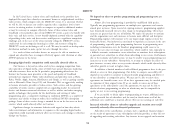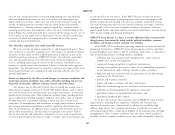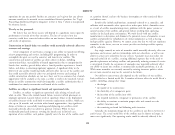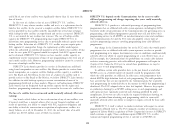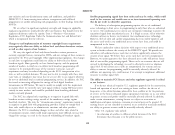DIRECTV 2011 Annual Report Download - page 38
Download and view the complete annual report
Please find page 38 of the 2011 DIRECTV annual report below. You can navigate through the pages in the report by either clicking on the pages listed below, or by using the keyword search tool below to find specific information within the annual report.DIRECTV
which in this Annual Report includes its progeny legislation, the Satellite reduced depending on the FCC’s interpretation of its rules and judicial
Home Viewer Improvement Act of 1999; the Satellite Home Viewer decisions. For example, the FCC issued an order requiring mandatory
Extension and Reauthorization Act of 2004; and the Satellite Television carriage of high-definition digital signals in an increasing number of markets
Extension and Localism Act of 2010) allows DIRECTV U.S. to retransmit each year, requiring so-called ‘‘HD carry-one, carry-all’’ in all local markets
the signals of local broadcast television stations in the stations’ local markets served by 2013. We may not be able to comply with these rules, or may be
without obtaining authorization from the holders of copyrights in the required to use capacity that could otherwise be used for additional local or
individual programs carried by those stations. Another portion of SHVA national programming.
also permits satellite retransmission of distant network stations (e.g., those •Retransmission Consent. For those local television broadcast stations that
that originate outside of a satellite subscriber’s local television market) only do not elect must carry, SHVA also requires DIRECTV U.S. to obtain
to ‘‘unserved households.’’ A subscriber qualifies as an ‘‘unserved household’’ consent prior to retransmitting their signals to viewers. Television broadcast
if he or she cannot receive, over the air, a signal of sufficient intensity from stations may withhold this consent (subject to a requirement to negotiate in
a local station affiliated with the same network, or falls into a few other good faith), and other provisions of copyright and communications law
very limited exceptions. SHVA also prohibits DIRECTV U.S. from signing prevent DIRECTV from providing duplicate out-of-market programming in
up a new subscriber to distant signals if that subscriber lives in a local many instances. Thus, where consent is withheld, DIRECTV U.S.
market where DIRECTV U.S. makes available the same-network local subscribers may lose access to popular programming.
signal. The FCC has required DIRECTV U.S. to delete certain
programming, including sports programming, from the signals of certain • Public Interest Requirement. The FCC has imposed certain public interest
distant stations. In addition, the FCC’s continuing interpretation, obligations on DBS operators, including a requirement that such providers
implementation and enforcement of other provisions of SHVA and judicial set aside four percent of channel capacity exclusively for noncommercial
decisions could hamper the ability of DIRECTV U.S. to retransmit local programming of an educational or informational nature, for which we must
and distant network and superstation signals, reduce the number of our charge programmers below-market rates and may not impose additional
existing or future subscribers that can qualify to receive these signals, impose charges on subscribers. FCC rules also require DIRECTV U.S. to comply
compliance costs on us, or subject us to fines, monetary damages or with a number of political broadcasting requirements and limits on the
injunctions. The distant signal provisions are set to expire in 2014. Congress commercialization of children’s programming. We believe that DIRECTV
may decline to renew those provisions, which could severely restrict our U.S. is in compliance with all of these requirements, but some require our
ability to retransmit distant signals. interpretations, which we believe are reasonable and consistent with industry
practice. However, the FCC may not agree.
•Must Carry Requirement. SHVA imposes a must carry obligation on
DIRECTV U.S. This requires satellite carriers that choose to take advantage • Emergency Alert System. The Emergency Alert System, or EAS, requires
of the statutory copyright license in a local market to carry upon request the participants to interrupt programming during nationally declared
signals of all qualifying television broadcast stations within that local market, emergencies and to pass through emergency information. The FCC has
subject to limited exceptions. The FCC has adopted further detailed rules adopted rules that require satellite carriers to comply with this requirement.
covering our carriage of both commercial and non-commercial broadcast It may also mandate that satellite carriers interrupt programming for local
television stations. These rules generally require us to carry all of the local emergencies and weather events. Any such requirement would be very
broadcast stations properly requesting carriage in markets in which we difficult to implement, would require costly changes to our DBS/DTH
retransmit the signals of local broadcast stations. The projected number of system, and, depending on how it is implemented, could inconvenience or
markets in which we can deliver local broadcast programming will continue confuse our viewers. The FCC is also considering whether to require that
to be constrained because of the must carry requirement and may be
14




